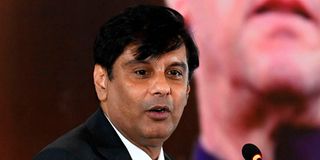Let us fight impunity fashioned on derailing journalism from all fronts

The late Pakistani journalist Arshad Sharif. He was shot dead at a police roadblock on the Nairobi-Magadi road.
The killing of Pakistani journalist Arshad Sharif has sent a chill down the spine of media stakeholders and concerned observers. Police accounts say the journalist was fatally shot after his car failed to stop at a roadblock in Kajiado County on October 23.
Since speculation will only deepen the mystery, investigations should be carried out swiftly and conclusively.
The incident came just days to the 2022 International Day to End Impunity for Crimes against Journalists (IDEI). The day, which marked every November 2, draws attention to impunity against journalists, which, according to the UN, is at an all-time high.
Way back, the UN Congress on Crime Prevention and Criminal Justice passed a declaration that isolated threats to journalists and called for a swift push to reverse the gloomy trend. Regrettably, however, safety of journalists remains a mirage in many jurisdictions.
Pressing issues
Globally, ending impunity for crimes against journalists is one of the most pressing issues to guarantee freedom of expression and access to information for all citizens. Between 2006 and 2020, more than 1,200 journalists were killed with close to nine out of 10 cases judicially unresolved, according to the Unesco’s Observatory of Killed Journalists.
Unesco posits that this cycle of violence against journalists is an indicator of the weakening of the rule of law and judicial system. In nine of 10 cases, the killers go unpunished.
The latest killing of Sharif speaks to the importance to respect and protect the work of journalists as human rights defenders. Impunity leads to killings, which are an extreme form of media censorship. Trends in the Middle East and other parts of Asia have particularly been worrying. Controversy still surrounds the killing of Palestinian-American journalist Shireen Abu Akleh, of Al Jazeera, who was shot by Israeli forces in May.
Cross-border efforts
Against that backdrop, more concerted cross-border efforts to protect journalists are necessary. Investigation and prosecution of those who mete out these injustices should be done with the full force of the law.
Top on the list of threats journalists face are kidnappings, torture, arbitrary, arrests, intimidation, harassment and attacks in the digital space. Women journalists have particularly borne the brunt of ruthless criminals out to disparage them and their work. Surveys show an upward of 70 per cent of female reporters have endured harassment online.
While the media is obliged to do its work in an ethical manner, it is the primary role of security agencies to protect journalists and every other citizen. The Media Council of Kenya (MCK) has been collaborating with the National Police Service to safeguard and protect media freedom while recognising the symbiotic relationship between the media and the security sector.
As UN Secretary-General António Guterres says, political will is required in ensuring journalists’ safety. We can build on the success stories in the war against impunity and lessons learnt with reference to different regions, countries and cases and their unique challenges. We have a role, individually and collectively, to ensure unconditional safety of every journalist. After all, journalism is not a crime.
Safety and Protection of Journalists
The National Mechanism for the Safety and Protection of Journalists was established in 2019 under the leadership of MCK, in collaboration with industry stakeholders. It assigns various roles and responsibilities of actors in aiding journalists to achieve the three Ps—Prevention, protection and prosecution. IDEI is a good opportunity for regulators, media owners, newsroom managers, security agencies and human rights defenders to examine our performance in its implementation.
While killing is the most serious offence against journalists, many more have been condemned to a live of living is asylum and safe houses because of the work they do.
Threats have also evolved. In Kenya, for instance, efforts at cooperation between media workers and law enforcement agencies have contributed to a reduced number of physical attacks on journalists on duty.
Going by recent trends, impunity against journalists has assumed the form of denial of both physical access and information—as seen in Parliament, Judiciary and county governments. The physical threats have moved online. While many journalists were not attacked physically, hundreds are trolled online.
Despite Kenya being ranked 69th out of 180 on the 2022 Press Freedom index, an improvement from last year’s 103, Unesco’s “World Trends in Freedom of Expression and Media Development: Global Report 2021/2022” indicated that 85 per cent of the people experienced a decline in press freedom in their country in the past five years.
Since January, MCK has documented 90 incidences press freedom violation, up from 70 last year. The jury is still out on how Kenya has fared on other indicators of press freedom, including media ownership, misinformation and legal and other forms of censorship.
Mr Omwoyo is the CEO of the Media Council of Kenya. [email protected].





